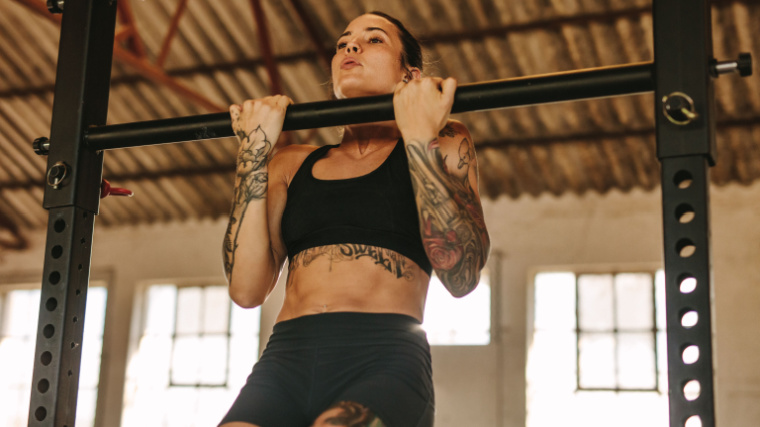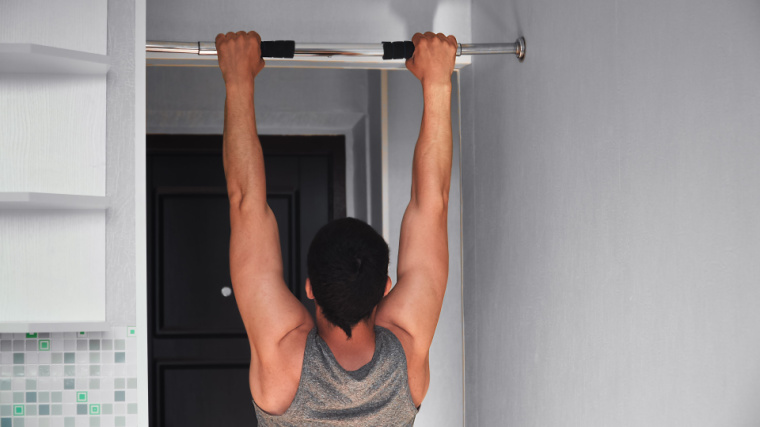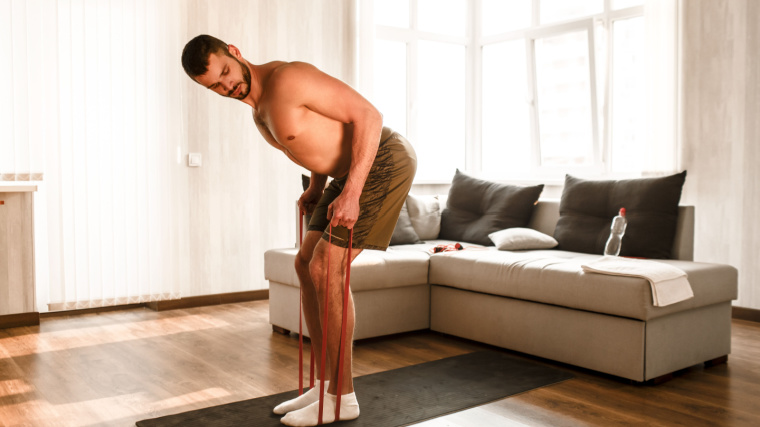Weight rooms are made for making muscle. They provide more tools than you could (probably) ever use to help craft the physique of your bodybuilding dreams. Unfortunately, unless there’s a cot tucked away in the back of the stretching area, you can’t be at your gym 24/7.
What, then, comes of your back training goals if you want to build massive lats but don’t have a lat pulldown station to work with? Do you need a Hammer Strength row to grow? No. As it turns out, you can blow up your backside just fine with the equipment you probably have in your garage.

So if you want to build a back as big as the house you live in, you need to know how to properly train without the lavishness of your local commercial gym. Here are three different workouts designed to do just that:
Best Home Gym Back Workouts
- Home Gym Bodybuilding Back Workout — Beginner
- Home Gym Bodybuilding Back Workout — Intermediate
- Home Gym Bodybuilding Back Workout — Advanced
What You’ll Need (in Your Home Gym)
Make no mistake, you need some resistance training equipment in your home or garage if you want to pursue noteworthy back gains. However, you also don’t need thousands upon thousands of dollars worth of steel and pulleys to make a dent.
The workouts in this guide will presume you have, at minimum, easy access to the following equipment. Stuff you can comfortably fit in a two-car garage. You can also think of the difficulty labels as synonymous with intricacy. The “Beginner” workout will require fewer tools than the “Advanced” workout, for instance.
A Barbell and Plates
Free weights should make up the backbone of your back workouts, most of the time at least. A barbell and some plates will enable you to perform all manner of rows, sure, but you can also use a bar lodged into a squat rack as a station to perform pull-ups or even inverted rows.
Of course, a bar is only as useful as the amount of weight you can slide onto it. If you don’t have a pile of plates lying around, you may have to make some substitutions.
Some Dumbbells
A set of (preferably) adjustable dumbbells are among the best investments you can make in your home gym. A large rack of pre-loaded dumbbells may fit comfortably into a commercial gym, but they can take up far too much space in a garage or converted room in your house.
If you have dumbbells, you can perform a variety of different rows, as well as some specialty upper-back-focused movements as well. A few pairs of pre-loaded ‘bells will do fine, but certain movements might be off-limits to you.
A Pull-Up Bar
Pull-ups are the best bodyweight movement for your back, bar none. However, you actually need something to pull yourself up on.
Whether that’s a specialty pull-up bar that latches onto a doorframe or a barbell set very high into a squat rack is up to you. Just make sure you have enough clearance below the bar to hang freely.
A Bench or Box
Many good back movements require you to sit, hinge, or lie prone on a stable surface. Pulling something against gravity is harder to set up than pushing an object vertically in space, after all.
An adjustable weight bench is ideal for home back workouts, but if you don’t have one, a plyometric box will do. In a real pinch, you can even sit on a large cooler or toolbox.
A Squat or Power Rack
A station in which to house your barbell opens up a large assortment of exercise options for your home workouts. Moreover, a squat or power rack also gives you somewhere to rest the bar when it is loaded up with plates.
That way, you don’t have to begin all your rows by deadlifting the implement off the ground, which should spare you some lower back fatigue.
Resistance Bands
Bands provide a two-for-one advantage in home workouts; not only do they help you isolate small muscles in a way that doesn’t pose a potential injury risk, you can also use bands to introduce some accommodating resistance.
Fixing a band to a barbell, dumbbell, or even your own body can help you increase the difficulty of an exercise if you’re limited by how much external weight you have access to.
Home Gym Bodybuilding Back Workout — Beginner
All bodybuilding beginners play by the same rules, whether you work out in a fully-furnished training facility or your own living room.
If anything, starting your bodybuilding journey at home is easier than making progress later in your career, since you’ll generally need fewer complex movements and lighter weights than your more tenured counterparts.
The Workout
A good beginner back workout accomplishes two things: It should introduce you to a variety of movement patterns involving the elbow and shoulder, and should take a “lean and mean” approach to your overall workload.
You’re also in the very fortunate position of benefitting from unweighted chin-ups and pull-ups. These calisthenics movements in their original state are generally too easy for certain gymgoers, but are plenty tough if you’re new to resistance training.
- Barbell Row: 3 x 6
- Pull-Up: 2 sets to failure
- Chin-Up: 2 sets to failure
- Resistance Band Pull-Apart: 2 x 15
Home Gym Bodybuilding Back Workout — Intermediate
A year or three of gym experience under your weight belt complicates things a bit if you’re trying to build your body from your garage. However, that hardly means gains are off the table.
You might need to pick up some extra weight plates to ensure the gains keep rolling in.
The Workout
As an intermediate, you’ll generally lean on the same training style as a beginner would. The difference is, you’ll need to get a little creative about adding extra resistance and volume, especially if your home gym isn’t particularly well-furnished. Fortunately, the nuts and bolts are the same.
- Barbell Row: 4 x 8, with a drop set at the end
- Barbell Upright Row: 4 x 12
- Wide-Grip Pull-Up + Barbell Shrug: 3 x 15 each, as a superset
Home Gym Bodybuilding Back Workout — Advanced
Muscle is harder to grow in your eighth or ninth year working out than when you first pick up a weight. This is, unfortunately, compounded by the limited equipment you likely have access to in a home facility.
However, that doesn’t mean back hypertrophy is a lost cause. With a bit of ingenuity (and a high degree of pain tolerance) you can add extra resistance to reliable back movements to generate a real muscle-making stimulus.
The Workout
The movements you’ll perform in an advanced home gym workout aren’t any different than what a beginner might go for. This is mainly a limitation of the equipment you have access to; you can only do so much with so little.
However, you can make those exercises appropriately challenging by lifting heavier, using accommodating resistance, and taking your tissues to the brink with high-octane supersets.
- Resistance Band Barbell Row: 4 x 6
- Dumbbell Seal Row + Reverse Flye: 3 x 12 each, as a superset
- Plate-Loaded Inverted Row + Snatch-Grip Shrug: 2 x 15 each, as a superset
- Pull-Up: 3 x 15, then one set of negative reps to failure
How to Make Progress at Home
Your home gym may not have thousands of pounds of plates to play with, but you can still make tangible progress. Your “lane” may simply look a bit different if you can’t execute progressive overload by adding another 10 pounds to your barbell.
Add Reps
In the absence of additional weight to work with, you can drive muscle growth by shooting for higher and higher reps. Contrary to popular belief, you can achieve substantial muscle growth with a wide array of set-rep schemes, including with rep counts as high as 15 or more. (1)

The caveat here is that you must train in the realm of muscular failure. So, sets of 20 chin-ups will certainly build your back, but only if you terminate the set with only a few reps left in the tank.
Reduce Rest
Another way you can create some progressive stimulus from workout to workout is by reducing the amount of time you rest between sets. This will increase the density of your training — you’re building your back with the same amount of weight moved, just in less time.
This winds up being more total tension applied to the tissue in question. However, take caution with your rest times for large compound exercises. If you’re out of breath or your stabilizer muscles are torched, take time to recuperate before performing another set of barbell rows.
Use Intensity Techniques
If you’re capped out on rep count and don’t want your bodybuilding sessions to feel like a conditioning workout, you can employ some tactical intensification techniques to drive muscle growth instead.
Supersets, rest-pause training, myo-reps, or forced negatives in some cases all work wonders here. They shouldn’t occupy the entirety of your training log, but they’re certainly appropriate in some cases.

Try pairing isolation movements together, or adding a few eccentric reps to your last set of pull-ups in the garage.
Benefits of Home Workouts
Weight rooms are great, but they may not be your ideal workout environment. What a home gym lacks in sheer square feet, it makes up for via convenience, accessibility, and ease of use.
If you’re on the fence about outfitting your home gym for bodybuilding, consider all the benefits it may provide. Here’s what you stand to gain by training at home.
More Convenience
The presumably tight space you train in at home can feel cramped sometimes, sure. But the flip side of this “issue” is that the equipment you need to make gains is, literally, at your fingertips.
You don’t have to cross a large facility to switch between exercises, only to find another patron on the only machine row station in the place. There’s no long commute to discourage you from getting yourself in gear after a long work day.
No Waiting for Equipment
Hand-in-hand with convenient facility access comes the blessing of not having to wait for equipment. It’s all too common in commercial gyms to have a picture-perfect workout entirely derailed by one inconsiderate patron who has camped out on some prime weight room real estate.

An otherwise-unoccupied home gym is great for more than shaving minutes off your session; with no other gymgoers to share with, you can easily configure your space for circuit training, supersets, or active warm-up protocols without worrying that you’re hogging equipment.
Access to Healthy Post-Workout Meals
Post-workout nutrition is integral to recovery, especially in the hour or two following a hard training session. That said, you may not bring a pre-made protein shake to the gym with you at all times. If you have a long commute home from your bodybuilding workout, it’s easy to go hungry and find yourself tempted to swing by the drive-thru.
Working out at home resolves this entirely — getting the nutrition you need is as easy as walking to the kitchen and grabbing your shake. If liquidized foods make you queasy, you can simply heat up a hot meal right after your last set.

Home bodybuilding workouts gain a lot of ground if you have a sensitive stomach or specific dietary parameters to adhere to.
A Back as Big as a House
Commercial gyms are great. They provide you with the resources you need to build muscle by the pound. However, if weight rooms were the only way to grow, they’d be packed to the brim.
Fortunately, you can build a mighty-impressive back right at home. It may take a bit more ingenuity and patience than you’re used to, but when the chips are down, effort is what matters. Apply enough effort to your at-home workouts and your back will be as broad as the walls of the home you train in.
References
1. Schoenfeld, B. J., Grgic, J., Van Every, D. W., & Plotkin, D. L. (2021). Loading Recommendations for Muscle Strength, Hypertrophy, and Local Endurance: A Re-Examination of the Repetition Continuum. Sports (Basel, Switzerland), 9(2), 32.
Featured Image: Jacob Lund / Shutterstock